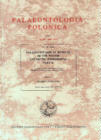| PALAEONTOLOGIA POLONICA VOL. 57 | ||
 |
Editor: Assistant editor: |
|
|
Andrzej PISERA Upper Jurassic siliceous sponges from the Swabian Alb - taxonomy and paleoecology |
|
Abstract: The fauna of siliceous sponges (hexactinellids and demosponges) from the Upper Jurassic of the Swabian Alb is described and revised. It consists of 124 species representing 67 genera. Only 15 species show frequency higher than 1% of the whole assemblage. Nearly all sponges represent groups with solid skeletons: Hexactinosa and Lychniscosa, and lithistid Demospongea. Loose spicules occurring are also described and illustrated. Two new species are proposed: lithistid Amphibleptula jurassica sp. n. and hexactinosan Sphenaulax irregularis sp. n. Several other new species are described in an open taxonomy. The presence or absence of dermal and/or gastral layers of pentactines or stauractines in Hexactinosa and Lychniscosa is of no taxonomic value, because it is mostly a taphonomical phenomenon, and both types of spicules can be present in the same species. Lithification of sponges leading to origin of the so called "sponge mummies" preserves (except in one lyssacinosan sponge) only parts of the sponges delimited by solid skeletal structures. The Oxfordian assemblage is dominated by hexactinosan and lychniscosan sponges, while beginning with the Kimmeridgian lithistid demosponges are very common. The proportion of lithistid sponges in the assemblage increases steadily and the uppermost Kimmeridgian assemblage consists mostly of lithistids. This trend is interpreted here in terms of superimposed bathymetric changes and type of food dominant in the environment: particulate (domination of lithistid demosponges) and colloidal (hexctinellids domination). Ecological analysis of the sponge fauna and sedimentological analysis of sponge-bearing sequences point to a relatively deep-water setting of the Upper Jurassic siliceous sponge biofacies: the most shallow mixed sponge-coral Upper Kimmeridgian assemblages dominated by lithistid demosponges could be from 60–100 meters, while Oxfordian hexactinellid dominated assemblages may be from as deep as 200–600 m. The apperance of rich siliceous sponge assemblages in the Upper Jurassic is mostly ecological phenomenon since the numerous genera contributing to this assemblage are rooted in the Lower Jurassic at least. Generally high sea level during the Upper Jurassic produced large, relatively deep water areas, remote from the shore and thus with slow sedimentation. Such new habitats suitable for sponges have been colonized by immigrants from refugia existing on continental and island slopes. Large sponge populations were supported by high nutrient availability characteristic for the Upper Jurassic. Key words: Siliceous sponges, Hexactinosa, Lychniscosa, Lithistida, taxonomy, paleoecology. |
|
Home | Editors | Current Issue | Archive | Instructions | Subscription | History | Institute of Paleobiologyy |
|
| ©
1997-2004. Instytut Paleobiologii PAN Web Site Design by Jarosław Stolarski Last updated 04-12-09 |
Best
viewed by Internet Exlorer 4.x or higher and |